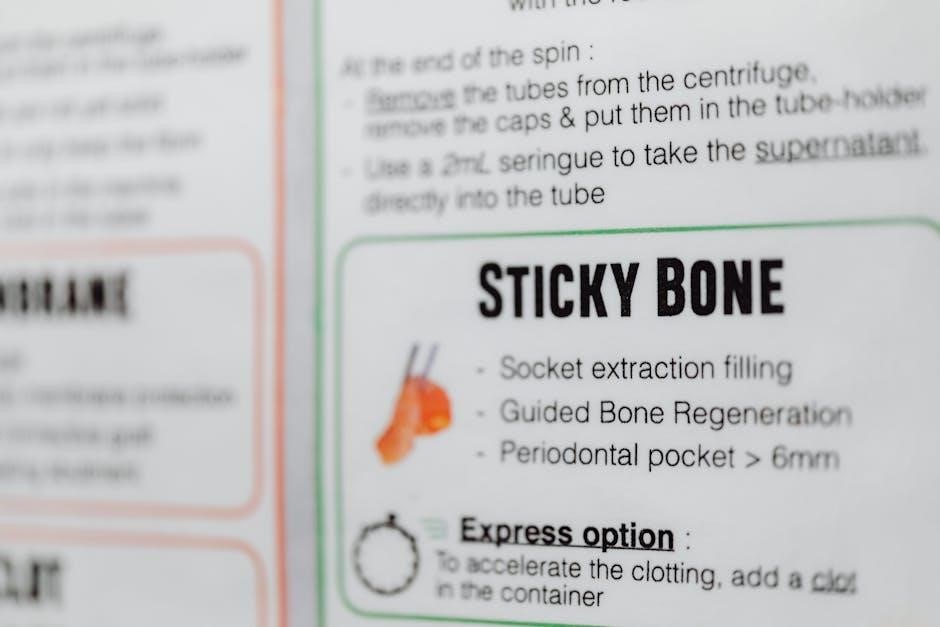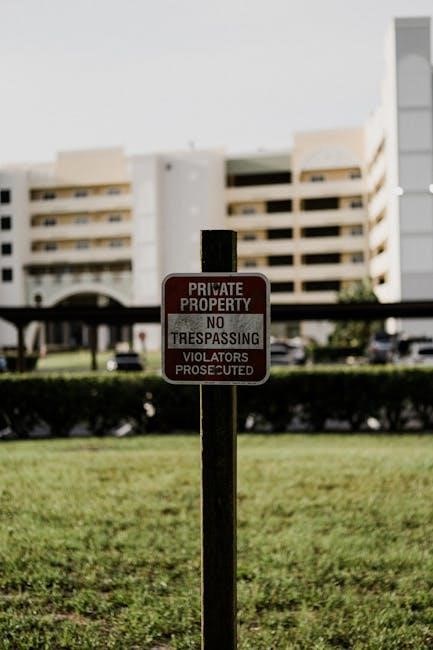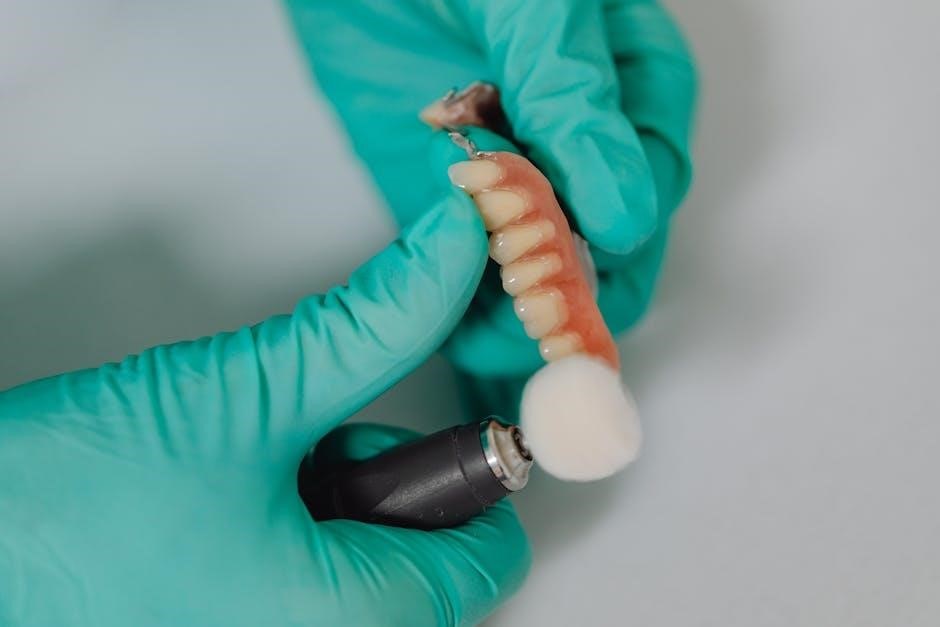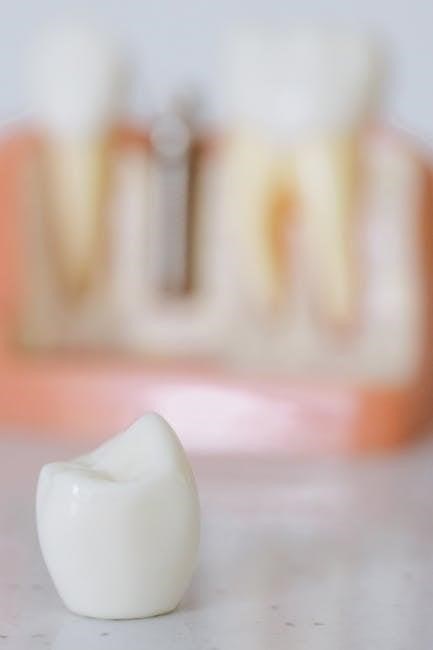Dental Implant Post-Op Instructions: A Comprehensive Guide
Following dental implant surgery, meticulous post-operative care is vital for successful osseointegration and long-term implant stability․
This guide details essential steps,
from immediate care to long-term maintenance, ensuring optimal healing and a functional, aesthetic result․
Remember to avoid disturbing the surgical site and adhere to dietary restrictions, prioritizing soft foods initially․ Proper oral hygiene and diligent follow-up appointments are key․
Immediate Post-Operative Care (First 24 Hours)
The initial 24 hours following dental implant surgery are crucial for initiating proper healing․ Prioritize rest and minimize physical exertion․ Do not disturb the surgical site – avoid any probing, touching, or manipulation of the area with fingers, tongue, or any objects․
Strictly avoid rinsing vigorously or spitting, as this can dislodge the forming blood clot, potentially leading to complications․ Gentle bleeding is normal; apply firm, consistent pressure with gauze over the surgical site for 30-60 minutes at a time until it subsides․
Absolutely refrain from smoking for at least two weeks, as it significantly impairs blood flow and hinders the healing process․ Maintain a liquid diet, and avoid any hot or spicy foods or beverages․ Expect some discomfort, and begin pain management as prescribed by your dentist․ A metal healing abutment may be visible; this is normal․
Do Not Disturb the Surgical Site
Maintaining the integrity of the surgical site is paramount during the initial healing phase․ Avoid any actions that could compromise the developing blood clot or disrupt the implant’s position․ This means absolutely no probing, touching, or manipulation of the area with your fingers, tongue, or any instruments․
Refrain from vigorous rinsing or spitting for the first 24 hours, as these actions can dislodge the clot, leading to a painful “dry socket” and potentially delaying healing․ Gentle bleeding is expected initially; apply consistent pressure with gauze to control it․
Avoid any unnecessary movement in the mouth, such as chewing on the surgical side․ A protruding healing abutment is normal and should not be tampered with․ Protecting the surgical area is vital for successful osseointegration and a smooth recovery process․
Dietary Restrictions: Liquid & Soft Foods

Following dental implant surgery, a carefully managed diet is crucial for optimal healing․ For the initial 24 hours, adhere strictly to a liquid diet – think clear broths, smoothies (without seeds!), and apple juice․ This minimizes disturbance to the surgical site and promotes clot stability․
After 24 hours, gradually introduce soft foods like yogurt, mashed potatoes, scrambled eggs, and well-cooked pasta․ Avoid anything requiring significant chewing effort․ Ensure foods are lukewarm or cool, as hot temperatures can increase swelling and discomfort․
Prioritize nutritionally balanced meals, even with dietary limitations․ Adequate protein intake supports tissue repair․ Continue with soft foods for at least a week, or longer if advised by your dentist, before slowly reintroducing more solid options․
Pain Management & Medication
Post-operative discomfort is normal after dental implant surgery․ Your dentist will likely prescribe pain medication – take it precisely as directed, even if you feel minimal pain initially, to proactively manage discomfort․ Do not exceed the prescribed dosage․
Over-the-counter pain relievers, such as ibuprofen or acetaminophen, may be used in conjunction with prescription medication, or as directed by your dentist, once you feel comfortable tapering off stronger pain relief․
Expect some discomfort to arise, but it should gradually subside over the first few days․ If pain intensifies or is not adequately controlled by medication, contact your dentist immediately․ Avoid alcohol as it can interact negatively with pain medication and hinder healing․
Swelling Control: Ice Packs
Managing swelling is crucial in the initial 24-72 hours following dental implant surgery․ Apply ice packs to the outside of your cheek in the area of the implant for 20 minutes on, and 20 minutes off․ This intermittent application helps constrict blood vessels, minimizing swelling and bruising․
Protect your skin by wrapping the ice pack in a cloth to prevent frostbite․ Continue this process consistently for the first 24 hours, then reduce frequency as swelling subsides․
Elevating your head while resting, even when sleeping, also aids in reducing swelling․ Avoid strenuous activity, as it can increase blood flow and exacerbate swelling․ If swelling significantly increases or is accompanied by fever, contact your dentist immediately, as it could indicate an infection․

Days 1-7: Early Recovery Phase
The first week requires gentle care․ Focus on maintaining oral hygiene with soft brushing, saline rinses, and a gradual diet progression․ Avoid strenuous activity to promote healing․
Oral Hygiene: Gentle Cleaning
Maintaining impeccable oral hygiene is paramount during the early recovery phase, yet it must be approached with extreme gentleness․ Avoid vigorous brushing or flossing directly around the implant site for the first few days․ Instead, use a soft-bristled toothbrush and gently clean the surrounding teeth and gums․
Focus on removing plaque and food debris without disturbing the surgical area․ You can carefully brush around the implant, but avoid direct contact with the healing abutment or sutures․ Consider using an antimicrobial mouthwash, as recommended by your dentist, to help control bacteria․
Be extremely cautious when cleaning near the surgical site․ Any aggressive action could disrupt the healing process or introduce infection․ Remember, keeping your mouth clean is crucial, but it must be balanced with the need to protect the delicate tissues that are healing around the new implant․ Follow your dentist’s specific instructions regarding cleaning techniques and products․
Rinsing Instructions: Saline Solution
Gentle rinsing with a saline solution is a crucial component of post-operative care, beginning typically 24 hours after surgery․ Prepare a solution by dissolving ½ teaspoon of non-iodized salt in 8 ounces (237 ml) of warm water․ Avoid vigorous swishing, as this can dislodge blood clots and impede healing․
Instead, gently tilt your head and allow the saline solution to flow passively over the surgical site․ Repeat this process several times a day, especially after meals, to keep the area clean and promote healing․ Do not use commercial mouthwashes containing alcohol, as they can irritate the surgical site․
Rinsing helps remove food particles and debris without disrupting the delicate healing tissues․ Continue saline rinses as directed by your dentist, typically for the first week or two․ Proper rinsing, combined with gentle cleaning, significantly reduces the risk of infection and supports optimal implant integration․
Diet Progression: Gradually Introducing Solid Foods
Following the initial liquid and soft food phase, a gradual progression to solid foods is essential; Begin by introducing very soft solids, like mashed potatoes, scrambled eggs, or well-cooked pasta, around days 3-5, depending on your comfort level and dentist’s recommendations․ Ensure these foods are easy to chew and do not require significant force․
As healing progresses, slowly incorporate slightly more textured foods, such as flaked fish, tender chicken, or soft fruits․ Avoid hard, crunchy, or chewy foods that could put stress on the implant site․ Listen to your body; if a food causes discomfort, revert to a softer consistency․
Continue this gradual progression over several weeks, ultimately returning to a normal diet․ Prioritize nutritious foods to support healing․ Remember, patience is key – a slow and steady approach minimizes the risk of complications and ensures successful implant integration․
Activity Restrictions: Avoiding Strenuous Exercise
Following dental implant surgery, it’s crucial to limit physical activity for the first few days to promote optimal healing․ Strenuous exercise, heavy lifting, and activities that increase blood pressure can disrupt the clotting process and potentially compromise the implant site․ Increased blood flow to the head can lead to prolonged bleeding or swelling․
For the initial 72 hours, restrict your activity to light walking and essential daily tasks․ Avoid running, jogging, weightlifting, and any activity that causes significant strain․ Gradually reintroduce exercise over the following weeks, starting with low-impact activities and slowly increasing intensity as tolerated․
Listen to your body and avoid pushing yourself too hard․ If you experience any pain or discomfort, stop immediately and rest․ Maintaining a calm and relaxed state will contribute to a smoother recovery process and successful implant integration․

Weeks 2-4: Intermediate Recovery Phase
During weeks two to four, continued gentle care is essential․ Attend scheduled follow-up appointments, monitor for any signs of infection, and maintain diligent oral hygiene practices․

Sutures & Follow-Up Appointments
Sutures, if present, will typically be removed during this intermediate phase, usually between weeks two and four․ Your dentist will schedule a specific appointment for suture removal, ensuring a clean and comfortable process․ It’s crucial to keep the area clean before this appointment, following the rinsing instructions provided․
Follow-up appointments are absolutely vital during weeks two to four․ These appointments allow your dentist to monitor the healing process, assess osseointegration (the fusion of the implant with the jawbone), and address any concerns you may have․ Radiographs (X-rays) may be taken to evaluate bone growth around the implant․
During these visits, your dentist will also check for any signs of infection or complications․ Don’t hesitate to report any unusual pain, swelling, redness, or discharge․ Adhering to the appointment schedule is a key component of a successful implant outcome, allowing for timely intervention if needed and ensuring long-term stability․
Monitoring for Infection: Signs & Symptoms
Vigilant monitoring for signs of infection is paramount during the recovery period․ While some discomfort is normal, escalating or unusual symptoms require immediate attention․ Be alert for excessive pain not relieved by prescribed medication, or pain that worsens over time․

Visible signs of infection include increased redness around the implant site, swelling that doesn’t subside, and pus or discharge emanating from the surgical area․ A fever of 100․4°F (38°C) or higher is also a concerning indicator․ Any unusual odor from the surgical site should be reported immediately․
If you experience any of these symptoms, contact your dentist promptly․ Early detection and treatment of infection are crucial to prevent complications that could jeopardize the implant’s success․ Do not attempt to self-treat; professional evaluation is essential․ Ignoring potential infection can lead to implant failure and further health issues․
Continued Oral Hygiene Practices

Maintaining impeccable oral hygiene is crucial throughout the recovery process and for the long-term success of your dental implant․ While initial cleaning must be gentle, consistent care prevents infection and promotes healing․ Continue brushing your teeth, but exercise extreme caution around the surgical site․
Use a soft-bristled toothbrush and avoid direct contact with the implant area for the first few weeks, as advised by your dentist․ Gently clean surrounding teeth to remove plaque and food debris․ Continue using the prescribed saline rinses as directed, avoiding vigorous swishing․
As healing progresses, your dentist will provide specific instructions on interdental cleaning methods, such as floss or interdental brushes․ These tools help remove plaque from hard-to-reach areas․ Consistent, gentle oral hygiene is the cornerstone of implant longevity and overall oral health․
Avoiding Hard or Crunchy Foods
Protecting your newly placed dental implant requires a temporary adjustment to your diet․ For several weeks following surgery, it’s essential to avoid hard or crunchy foods that could potentially damage the implant site or sutures․ This includes items like nuts, seeds, ice, popcorn, and crunchy vegetables․
These foods exert excessive force on the implant during chewing, which can disrupt the healing process and compromise osseointegration․ Stick to soft, easily chewable foods like yogurt, mashed potatoes, scrambled eggs, and well-cooked pasta․ Gradually reintroduce slightly firmer foods as your dentist approves․
Adhering to these dietary guidelines minimizes the risk of complications and ensures optimal healing․ Remember, patience is key; a temporary dietary modification is a small price to pay for a successful and long-lasting dental implant․

Long-Term Care & Maintenance
Maintaining implant health necessitates regular dental check-ups, diligent oral hygiene, and avoiding smoking․ Long-term success relies on proactive care and promptly addressing any concerns with your dentist․
Importance of Regular Dental Check-ups
Consistent professional maintenance is paramount for the longevity of your dental implant․ Routine check-ups, typically every six months, allow your dentist to monitor the implant’s stability, assess the surrounding gum tissue, and identify any potential issues early on;
These appointments aren’t simply about checking for problems; they include a professional cleaning to remove plaque and calculus buildup that can lead to peri-implantitis – an inflammation around the implant․ Early detection of peri-implantitis is crucial, as it can jeopardize the implant’s success if left untreated․
During these visits, your dentist will also evaluate your bite to ensure it’s not placing undue stress on the implant․ Adjustments can be made if necessary․ Furthermore, X-rays may be taken periodically to assess the bone support around the implant․ Remember, proactive care is far more effective – and less costly – than reactive treatment․
Potential Complications & When to Contact Your Dentist
While dental implant surgery boasts a high success rate, potential complications can occur․ These include infection at the implant site, nerve damage (though rare), sinus problems if the implant is in the upper jaw, and implant failure․ Swelling and discomfort are normal initially, but excessive or worsening pain warrants attention․
Contact your dentist immediately if you experience signs of infection – increased pain, redness, swelling, pus, or fever․ Numbness or tingling that persists beyond a few days should also be reported․ Any loosening of the implant or significant changes in your bite require prompt evaluation․

Don’t hesitate to reach out if you’re concerned about anything, even if it seems minor․ Early intervention can often prevent small issues from escalating into larger problems․ Remember, your dentist is your partner in ensuring a successful and lasting implant outcome․
Smoking & Alcohol: Impact on Healing
Both smoking and excessive alcohol consumption significantly impede dental implant healing and increase the risk of complications․ Smoking restricts blood flow to the gums, hindering osseointegration – the crucial process where the implant fuses with the jawbone․ This can lead to implant failure․
Alcohol, particularly in large amounts, can interfere with the body’s healing mechanisms and interact negatively with pain medication․ It also increases the risk of infection․ It is strongly recommended to abstain from smoking for at least two weeks post-surgery, and ideally, for much longer to maximize success․
Limiting or avoiding alcohol during the initial healing phase is equally important․ Your dentist may provide specific recommendations based on your individual health and the extent of your surgery․ Prioritizing a healthy lifestyle will dramatically improve your implant’s long-term viability․
Long-Term Diet Considerations for Implant Success
Maintaining a balanced and nutritious diet is crucial for the long-term success of your dental implant․ While implants themselves aren’t susceptible to decay, the surrounding gums and bone require optimal health to support them․ Focus on consuming a diet rich in vitamins and minerals, particularly calcium, vitamin D, and vitamin C, to promote bone density and tissue health․
Avoid consistently consuming excessively sugary or acidic foods and beverages, as these can contribute to gum inflammation and potentially compromise the supporting tissues․ While you can generally eat most foods with an implant, it’s wise to continue avoiding extremely hard or sticky substances that could place undue stress on the implant․
Regularly incorporating a variety of nutrient-dense foods will contribute to overall oral health and ensure the longevity of your dental implant investment․ Prioritize whole foods and stay hydrated for optimal healing and maintenance․
